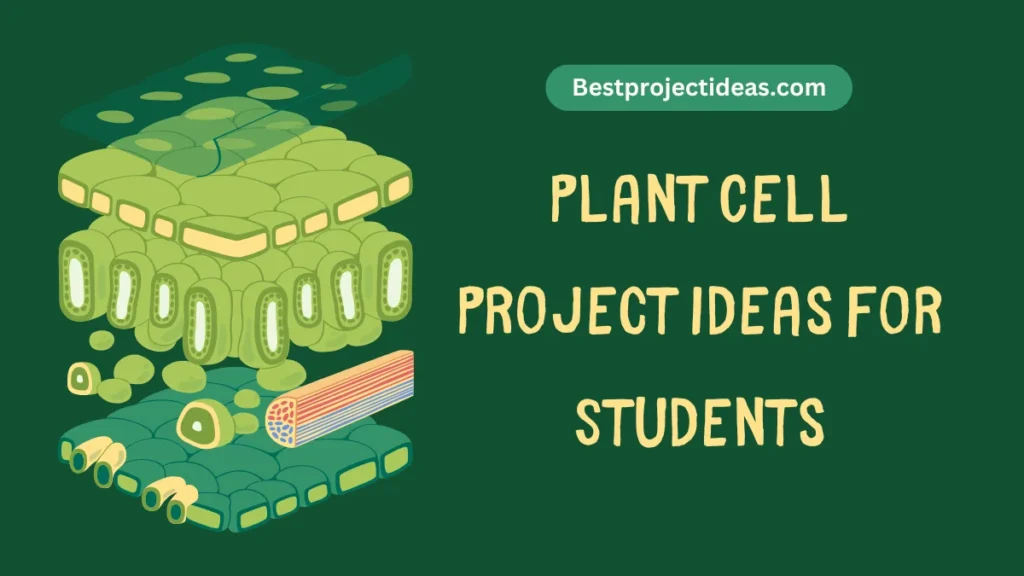
Creating a plant cell project is an excellent way for students to understand the structure and function of cells. This project can be interactive, creative, and educational, making it easier to learn complex biology concepts.
These projects provide a hands-on approach to understanding plant cells and their organelles.
Why Are Plant Cell Project Ideas So Important?
Plant cell projects are important because they offer a practical and visual way to understand biology concepts. Instead of just reading about the structure of a plant cell, students can build models, create diagrams, or use technology to see how cells function. This approach helps to:
- Simplify learning: Visual and hands-on projects make complex topics easier to grasp.
- Encourage creativity: Students can express creativity through models, drawings, or digital simulations.
- Promote active learning: Engaging in a project makes students more involved in their education.
Benefits of Doing a Plant Cell Project
- Better Understanding of Biology: A plant cell project helps you understand the functions and roles of different cell organelles.
- Hands-on Learning: You get to build and interact with the plant cell model, which aids memory retention.
- Enhances Creativity: Whether you make a 3D model or draw diagrams, these projects allow you to think creatively.
- Improves Problem-Solving Skills: You learn to research, plan, and execute the project, which develops problem-solving skills.
- Boosts Presentation Skills: Presenting your plant cell project enhances communication and presentation abilities.
Read More: 121+ New Science Project Ideas For Students With PDF
Plant Cell Project Ideas for High School Students
List of best Plant Cell Project Ideas for High School Students:
Model and Display Projects
- Build a large plant cell with colorful clay, labeling all the parts.
- Create a plant cell cake using candies to represent different parts.
- Make a plant cell diorama inside a clear plastic box.
- Design a plant cell with beads and strings on a canvas.
- Build moving cell parts using rubber bands and simple machines.
- Craft a plant cell model from recycled materials at home.
- Make a glowing plant cell model showing energy movement.
- Create a plant cell puzzle with organelle pieces that can be removed.
- Design a hanging mobile of plant cell parts.
- Build a plant cell model using ingredients from the kitchen.
- Make a see-through plant cell with clear plastic containers.
- Create a plant cell board game where organelles can move.
- Design a plant cell using colourful lights and working switches.
- Build a working model showing water moving through cells.
- Make a plant cell from craft materials with different textures.
- Create an expandable plant cell model using accordion paper.
- Design a plant cell treasure box with compartments for organelles.
- Build a plant cell model with magnetic parts that stick together.
- Make a plant cell snow globe with floating organelles.
- Create a plant cell model using pasta shapes.
Digital Projects
- Make a plant cell video game showing organelle functions.
- Create an animated movie about plant cell parts working together.
- Design a digital plant cell where you can click organelles for info.
- Build a plant cell website with interactive learning games.
- Make a virtual reality tour inside a plant cell.
- Create a plant cell app showing cell growth and division.
- Design digital flashcards about plant cell functions and parts.
- Build an online quiz game about plant cell processes.
- Make a digital comic book about plant cell adventures.
- Create an interactive plant cell diagram using coding.
- Design a plant cell screensaver showing organelle movement.
- Build a digital microscope viewer showing real plant cells.
- Make an augmented reality experience to learn about plant cells.
- Create a plant cell podcast explaining organelle roles.
- Design a digital colouring book about plant cells with facts.
- Build a simulation showing photosynthesis in plant cells.
- Make a digital matching game with organelle names and sounds.
- Create an online dictionary of plant cells with pictures.
- Design a plant cell social media page sharing daily fun facts.
- Build a digital tracker for plant cell growth and data.
Art and Creative Projects
- Paint a large plant cell mural with bright colours.
- Draw a comic strip about plant cells with funny jokes.
- Create a sculpture of a plant cell using plastic bottles.
- Make a quilt showing plant cells with different fabric pieces.
- Design stickers of plant cells showing organelle functions.
- Build a puppet show featuring moving plant cell parts.
- Craft a mosaic of a plant cell with small paper pieces.
- Make jewellery inspired by organelle shapes in plant cells.
- Create a pop-up book about plant cells with moving parts.
- Design greeting cards with hidden science facts about plant cells.
- Build a shadow box showing layers of a plant cell.
- Make plant cell origami with folded paper designs.
- Design stamps of plant cells using rubber and ink.
- Create window clings showing plant cell organelles.
- Build a wind chime with plant cell-themed parts.
- Make wrapping paper with plant cell patterns.
- Design a scrapbook about plant cells with photos and labels.
- Create bookmarks showing organelle functions in plant cells.
- Build picture frames with plant cell-themed decorations.
- Make wall decals about plant cells with fun facts.
Interactive Learning Projects
- Make a plant cell matching game with cards for each part.
- Create a board game where players learn about plant cells.
- Design a scavenger hunt about plant cells at school.
- Build a trivia game with questions about plant cells.
- Make a bingo game featuring organelle names in plant cells.
- Create a memory game with matching plant cell organelles.
- Design a puzzle with interlocking plant cell pieces.
- Build a word search featuring plant cell terms.
- Make a crossword puzzle with clues about plant cells.
- Create a dice game with challenges to learn about plant cells.
- Design a sorting game where cards represent plant cell categories.
- Build a domino game with plant cell parts that match.
- Make a Jenga game with fact blocks about plant cells.
- Create a spin wheel with questions about plant cells.
- Design a hopscotch game teaching plant cell steps.
- Build a ring toss game with labelled organelle targets.
- Make a bean bag toss with scoring tied to plant cell knowledge.
- Create a race game board with plant cell challenges.
- Design a treasure hunt for plant cells with clue cards.
- Build a quiz show about plant cells with team scoring.
Science Investigation Projects
- Observe plant cells under a microscope and record changes daily.
- Test different stains to see plant cell parts more clearly.
- Compare plant cells from leaves of different plant types.
- Measure how salt changes the size and shape of plant cells.
- Study how light affects the movement of chloroplasts in plant cells.
- Track how plant cells change during leaf colour changes.
- Test how temperature affects the membranes of plant cells.
- Record changes in plant cells under different growing conditions.
- Study how plant cell walls react to different solutions.
- Test how sugar levels affect plant cell functions.
- Observe how plant cells react to environmental stress.
- Compare cells from young leaves and older leaves.
- Study water movement through plant cell membranes.
- Watch and record the stages of plant cell division.
- Track changes in plant cell size during growth stages.
- Study how plant cells store and use energy differently.
- Examine the patterns of plant cell walls in various plants.
- Investigate how plant cells repair themselves over time.
- Compare cells from the roots, stems, and leaves of a plant.
- Study how plant cells communicate with one another.
Writing and Communication Projects
- Write a diary from the perspective of an organelle in a plant cell.
- Create a plant cell newspaper with daily science updates.
- Make a storybook that explains plant cell parts in simple ways.
- Write a poetry book about plant cells with colourful drawings.
- Create letters between organelles as if they were friends.
- Make a plant cell magazine filled with fun science articles.
- Write a guidebook about plant cells for new science students.
- Create an alphabet book with plant cell terms and fun facts.
- Write riddles about organelles and their functions.
- Design a travel guide for an imaginary trip through a plant cell.
- Make a joke book filled with plant cell-themed jokes.
- Create a recipe book using foods to represent plant cell parts.
- Write mystery stories about processes inside plant cells.
- Create a plant cell field guide for observing cells in nature.
- Make a book filled with activities about plant cells.
- Design a journal for exploring and recording plant cell facts.
- Write pretend interviews with plant cell organelles.
- Create a research report on plant cells with interesting details.
- Make a handbook about plant cells with key information.
- Write an adventure story featuring plant cell processes.
Educational Game Projects
- Create a memory card game with plant cell organelles.
- Design a plant cell version of Snakes and Ladders.
- Make a quiz show game with plant cell questions and buzzers.
- Build a Monopoly-style game about plant cell parts.
- Design a bingo game featuring scientific terms about plant cells.
- Create a scavenger hunt about plant cells in the classroom.
- Make a charades game about organelles and their functions.
- Design a Jenga game where each block includes a plant cell fact.
- Build a trivia game with plant cell-themed question cards.
- Create a matching pairs game with pictures of plant cell parts.
- Design a word search with plant cell-related terms.
- Make a crossword puzzle with clues about plant cell processes.
- Build a board game with challenge spaces about plant cells.
- Create a card sorting game to learn organelle categories.
- Design a dice game with learning tasks about plant cells.
- Make a domino game with matching organelles and their jobs.
- Build a ring toss game with organelle targets and labels.
- Create a bean bag toss with points for plant cell knowledge.
- Design a treasure hunt with clues about plant cells.
- Make a quiz show game where teams earn points for answers.
Technology Integration Projects
- Create animations showing plant cell growth and changes.
- Design virtual reality tours of plant cell structures.
- Make interactive apps about plant cells with fun games.
- Build online quizzes about plant cells with instant feedback.
- Create digital flashcards to study plant cell parts and functions.
- Develop augmented reality experiences to explore plant cells.
- Design plant cell simulation games for learning processes.
- Build digital microscope views of real plant cells.
- Create video tutorials explaining plant cell processes.
- Make podcasts discussing plant cell organelles and their roles.
- Design moving screensavers that show cell activities.
- Build websites with interactive plant cell learning tools.
- Create social media posts sharing fun facts about plant cells.
- Make presentation slides with animations about plant cells.
- Design video games that challenge players to learn about cells.
- Build digital art pieces of plant cells with clear labels.
- Make stop-motion videos showing processes like photosynthesis.
- Create digital comics that tell plant cell stories.
- Design computer models showing different organelle functions.
- Build virtual labs for experimenting with plant cells online.
Hands-on Construction Projects
- Build a giant plant cell using recycled cardboard boxes.
- Create a plant cell diorama inside a shoebox with labelled parts.
- Make a plant cell with different coloured modelling clay.
- Design a plant cell with beads and string as a 3D artwork.
- Build a plant cell using everyday household items creatively.
- Make a textured plant cell using pieces of fabric and felt.
- Create a plant cell using paper mache for organelle shapes.
- Design a plant cell with foam board and colourful paint.
- Construct a plant cell using popsicle sticks and glue.
- Make a layered plant cell using colourful sand to show parts.
- Create a plant cell using dry pasta shaped like organelles.
- Design a plant cell with pipe cleaners in bright colours.
- Build a plant cell model using clear plastic containers.
- Make a plant cell with buttons representing different organelles.
- Create a plant cell with playdough shaped into functional parts.
- For details, design a plant cell with layers of tissue paper.
- Build a plant cell using beans sorted by size and colour.
- Make a plant cell model using paper plates for sections.
- Create a plant cell with string art techniques for textures.
- Design a plant cell with coloured rice grains as organelles.
Presentation and Display Projects
- Create a poster showing a plant cell with movable parts.
- Make a slideshow presentation with plant cell facts and pictures.
- Design a bulletin board display featuring a 3D plant cell.
- Build a display case with a detailed plant cell model.
- Create a science fair board explaining plant cell structures.
- Make a wall chart with labelled organelles and their jobs.
- Design an information kiosk with plant cell learning materials.
- Build an interactive exhibition with plant cell games and models.
- Create a showcase with lights to highlight plant cell parts.
- Make a window display using colourful filters to show cells.
- Design a photo gallery with close-up images of real plant cells.
- Build a documentary video with students narrating cell processes.
- Create a demonstration table with plant cell experiments.
- Make an exhibit where visitors can touch and explore cell models.
- Design a museum-style display with cards explaining organelles.
- Build a learning centre with plant cell activities and visuals.
- Create a presentation about plant cells with engaging visual aids.
- Make a walking tour with stops to explain each cell part.
- Design an open house featuring student-led plant cell projects.
- Build a rotating theme showcase to teach different cell concepts.
Tips for Choosing the Best Plant Cell Project
- Understand Your Audience: If you are making the project for a class, consider what would impress your teachers and classmates.
- Choose Your Materials Wisely: Select materials that are easy to work with, such as clay, paper, or digital tools for virtual models.
- Consider Your Time: Pick a project that fits the time you have. A 3D model may take more time, while a drawing could be quicker.
- Be Creative: Don’t be afraid to think outside the box! You can use common household materials or even edible items like cake or candy to create your plant cell.
- Research Thoroughly: Make sure to fully understand the parts of the plant cell so that you can accurately represent them in your project.
How to Make Your Plant Cell Project Stand Out
- Add Unique Labels: Instead of regular labels, add short descriptions to explain what each organelle does.
- Use Unconventional Materials: Try using materials like yarn, foam, or even recycled items to create an eco-friendly project.
- Incorporate Technology: If possible, create a video or a digital version of your project that can be shared online.
Wrap Up
A plant cell project is more than just an assignment—it’s an opportunity to explore biology creatively and interactively.
Whether you create a clay model, draw a detailed diagram, or design an interactive digital model, you’ll gain a deeper understanding of plant cells and how they function.
By following the tips and ideas provided, you can create a project that’s not only informative but also enjoyable.

